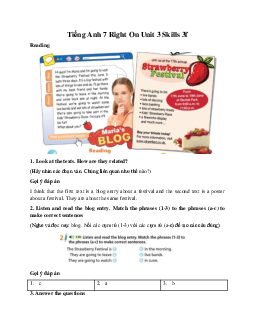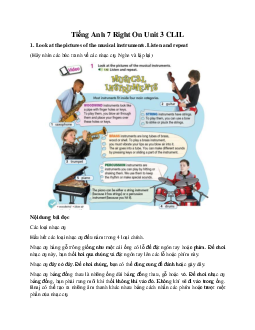

Preview text:
Tiếng Anh 7 Right On Unit 3 Right On 3 Project Time 3
1. a. Listen to the music extracts (1-5). Match them to the musical instruments (a-e) below.
(Nghe các đoạn nhạc (1-5). Nối chúng với các nhạc cụ (a-e) bên dưới.) Gợi ý đáp án 1. b 2. e 3. a 4. d 5. c
b. Match the countries (1-5) to their traditional instruments (a-e).
(b) Nối những quốc gia (1-5) với nhạc cụ truyền thống (a-e).) Gợi ý đáp án 1. b 2. d 3. e 4. a 5. c
2. Collect information about a traditional musical instrument in your country or
other countries under the headings name, type, description and other facts. Create a poster.
(Thu thập thông tin về các nhạc cụ dân tộc ở nước bạn hoặc nước khác dưới các đề mục
tên, loại, miêu tả và các sự thật khác. Tạo một tấm áp phích.) Presentation Skills
3. Use the poster in Exercise 2 to give a presentation about a traditional musical instrument.
(Sử dụng áp phích của bài 2 để thuyết trình về nhạc cụ truyền thống.) Gợi ý đáp án
“Where words fail, music speaks,” said Hans Christian Andersen. Look at this picture.
Do you know what this instrument is? It’s the đàn nguyệt, a traditional Vietnamese string instrument.
The đàn nguyệt is a two-stringed instrument and it looks like a guitar.
To play the đàn nguyệt, you need to pluck the strings with a small plectrum or guitar
pick. This takes a lot of skills because it only has two strings!” Music appreciation
4. a) Read the statements. Which do you agree with? Which do you disagree with?
Why? Discuss with you partner?
(Đọc các mệnh đề. Bạn đồng ý/không đồng ý với mệnh đề nào? Tại sao? Thảo luận với bạn cùng bàn.)
b) Think. Choose a piece of music. Draw a picture or think of a story. Present it to the class.
(Suy nghĩ. Chọn một bản nhạc. Vẽ tranh hoặc nghĩ ra một câu chuyện. Thuyết trình trước lớp.)



